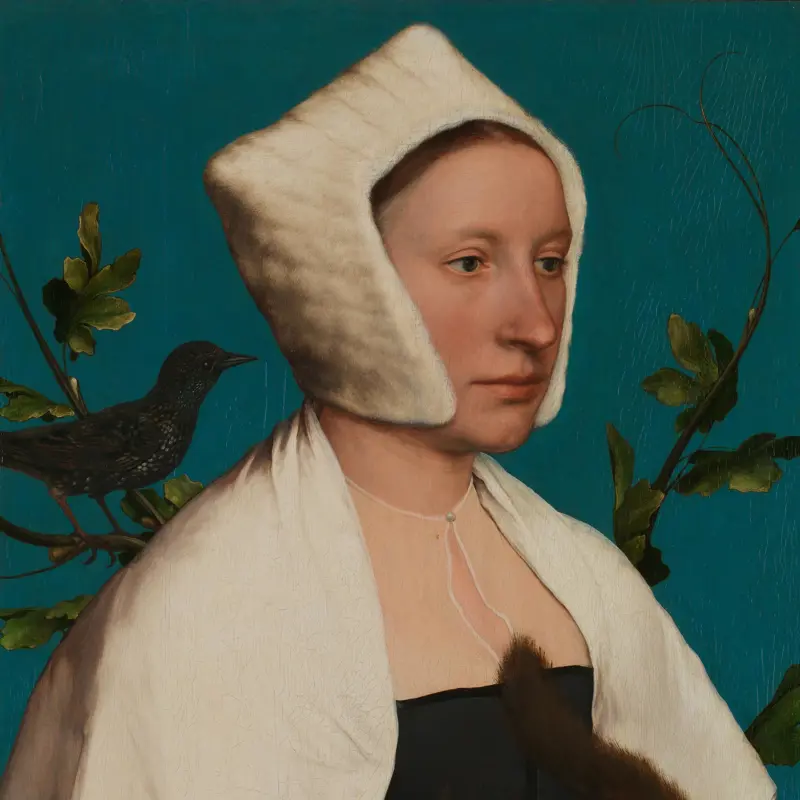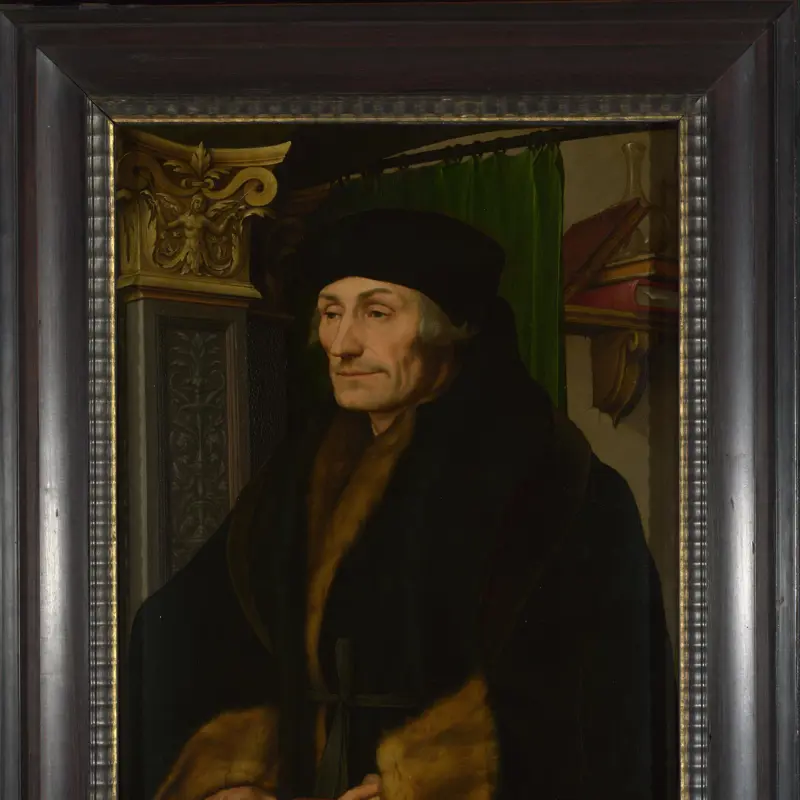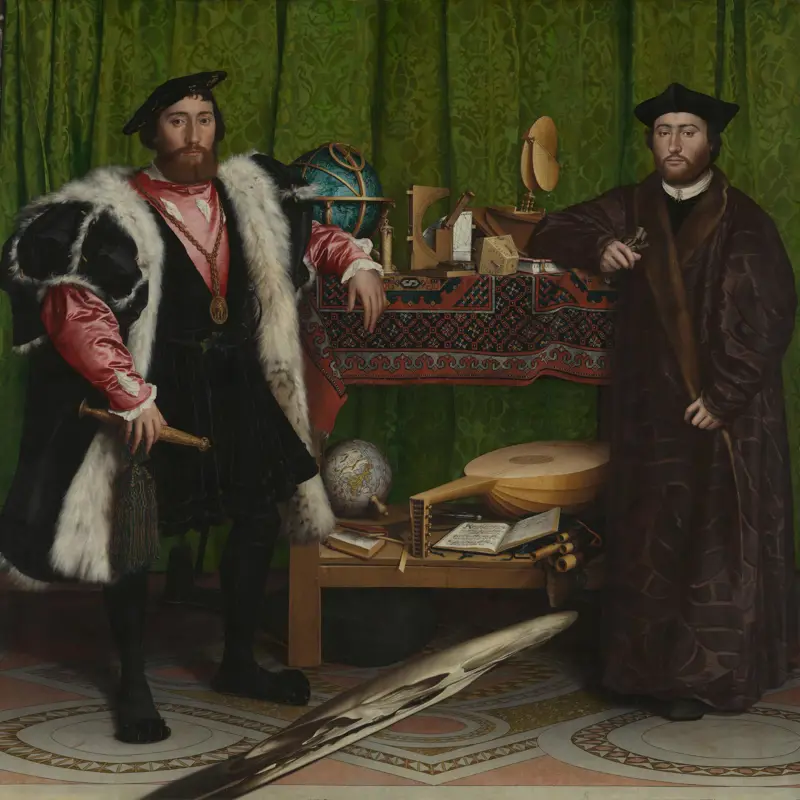Hans Holbein the Younger, 'Christina of Denmark, Duchess of Milan', 1538
About the work
Overview
This elegant young woman is Christina of Denmark, the youngest daughter of King Christian of Denmark. In 1538, King Henry VIII of England was looking for a fourth wife, after the death of Jane Seymour the previous year. As Henry’s official court artist, Holbein was sent to Brussels to capture the 16-year-old Christina’s likeness.
It’s recorded that Holbein’s sitting with Christina only lasted from 1 to 4 p.m. on 12 March 1538. This is when he made a series of sketches to use as the basis for the painted portrait. The image apparently pleased Henry so much that he was reported to be ‘in better humour than he ever was, making musicians play on their instruments all day long'. Although their marriage negotiations failed, Henry kept Christina’s portrait until his death in 1547.
Audio description
Listen to an audio description of Hans Holbein the Younger's 'Christina of Denmark, Duchess of Milan'
Transcript
This is a description of Christina of Denmark painted by Hans Holbein the Younger in 1538. It is oil on oak panel and is 1.8 metres high and just over 80 cm wide. It is in a plain wooden frame.
Sixteen-year-old Christina of Denmark stands full-length, facing us, a blue-green wall behind her. Her figure almost fills the tall rectangle of the painting. There is a pale brown floor underfoot. Dressed entirely in black, only the pale skin of her face and hands is uncovered. Her hair is hidden by a tight fitting cap which encloses her face. It is smooth and calm, with generous, orange-pink lips, a small pointed chin, and dark almond shaped eyes under pale brows. Her hands are clasped in front of her, just below the waist, holding pale leather gloves, and on the fourth finger of her left hand she wears a ring with a red stone.
Her black clothing is made from sumptuous fabrics. She wears a satin coat, that falls in generous folds to the floor, with gathered sleeves that balloon out from her shoulders. The coat is open at the front, where the brown fur lining is visible, as a narrow trim running all the way down to the floor, as well as at the cuffs, and forming a raised collar. Holbein’s incredibly skilled use of oil paint recreates the light catching the smooth folds of black satin, so different from the texture of the fur.
There is a glimpse of her plain black dress beneath the coat, with a high collar, and tied at the waist with a black silk ribbon. A fine white undershirt shows in soft ruffles at the neck and cuffs, edged in a fine black line.
Her figure is in fact very slightly angled to our left, her gown billowing out a little to the right, giving a subtle sense of movement. Bright light falls from top right so her figure casts a shadow on the wall to our left. A narrow band of mysterious shadow runs down the right-hand side of the painting. All these elements give her figure a sculptural, three-dimensional quality, her position in the rectangle of the painting emphasising her height and strong dignified presence.
Despite her youth Christina is in mourning for her husband. She had been married to the Duke of Milan when she was eleven, in 1533. Much older than her, the Duke died two years later and Christina returned to Brussels. She was a member of one of the most powerful families in Europe, the Habsburgs, and therefore a highly desirable bride.
In England Henry 8th’s third wife, Jane Seymour, had died, and he was considering suitable new matches. Unable to visit all potential brides in person he sent his court painter Hans Holbein the Younger to take her likeness in person. Christina sat for him in Brussels for three hours, as she described, while he made drawings. It was important they were accurate rather than flattering, and also full-length, unusual at the time for portraits of women – so that Henry could judge every aspect of her.
Back in London the King was delighted with what he saw and immediately commissioned the painting. However, the marriage plans broke down – luckily some might say for Christina who went on to have an apparently happy marriage as the Duchess of Lorraine. Although Henry married three more times he kept Christina’s portrait till his death.
Key facts
Details
- Full title
- Christina of Denmark, Duchess of Milan
- Artist
- Hans Holbein the Younger
- Artist dates
- 1497/8 - 1543
- Date made
- 1538
- Medium and support
- Oil on wood (Baltic/Polish oak, identified)
- Dimensions
- 179.1 × 82.6 cm
- Acquisition credit
- Presented by the Art Fund with the aid of an anonymous donation, 1909
- Inventory number
- NG2475
- Location
- Room 11
- Collection
- Main Collection
- Previous owners
- Frame
- 21st-century Replica Frame
Provenance
Additional information
Text extracted from the ‘Provenance’ section of the catalogue entry in Susan Foister, ‘National Gallery Catalogues: The German Paintings before 1800’, London 2024; for further information, see the full catalogue entry.
Exhibition history
-
2008Renaissance Faces: Van Eyck to TitianThe National Gallery (London)15 October 2008 - 18 January 2009
-
2014Strange Beauty: Masters of the German RenaissanceThe National Gallery (London)19 February 2014 - 11 May 2014
Bibliography
-
1813J. Hodgson and F.C. Laird, The Beauties of England and Wales: Nottinghamshire, London 1813
-
1854G.F. Waagen, Treasures of Art in Great Britain: Being and Account of the Chief Collections of Paintings, Drawings, Sculptures, Illuminated Mss. […], vol. 2, trans. E. Eastlake, London 1854
-
1874A. Woltmann, Holbein und seine Zeit, 2nd revised edn, 2 vols, Leipzig 1874
-
1880Royal Academy of Arts, Exhibition of Works by the Old Masters, and by Deceased Masters of the British School (exh. cat. Royal Academy of Arts, 1880), London 1880
-
1909M.W. Brockwell, 'Holbein's Portrait of Christina Duchess of Milan', The Connoisseur, XXIV, 1909, pp. 183-4
-
1912L.H. Cust, 'Notes on the Collections Formed by Thomas Howard, Earl of Arundel and Surrey, K. G.-V', The Burlington Magazine, XXI/113, 1912, pp. 256-8
-
1913J. Cartwright, Christina of Denmark, Duchess of Milan and Lorraine, London 1913
-
1913A.B. Chamberlain, Hans Holbein the Younger, London 1913
-
1924D.S. MacColl, 'Twenty-One Years of the National Art Collections Fund', The Burlington Magazine, XLIV/253, 1924, pp. 174-9
-
1929G. Vertue, 'Vertue Note Books, I', The Walpole Society, XVIII, 1930
-
1935G. Vertue, 'Vertue Note Books, IV', The Walpole Society, XXIV, 1936
-
1946Davies, Martin, National Gallery Catalogues: British School, London 1946
-
1950P. Ganz, The Paintings of Hans Holbein (first Complete Edition), London 1950
-
1951G. Ring, 'Three Works of the "Regent Master" at the Royal Academy', The Burlington Magazine, XCIII/576, 1951, pp. 88-92
-
1956J. Plesters, 'Cross-Sections and Chemical Analysis of Paint Samples', Studies in Conservation, II/3, 1956, pp. 110-57
-
1957D. Piper, 'The1590 Lumley Inventory: Hilliard, Segar and the Earl of Essex - I', The Burlington Magazine, XCIX/652, 1957, pp. 223-5
-
1959Levey, Michael, National Gallery Catalogues: The German Schools, London 1959
-
1959R. Strong, 'Federigo Zuccaro's Visit to England in 1575', Journal of the Warburg and Courtauld Institutes, XXII/43193, 1959, pp. 359-60
-
1968M. Levey, Holbein's Christina of Denmark, Duchess of Milan, London 1968
-
1971A. Salvini and H.W. Grohn, L'opera pittorica completa di Holbein il Giovane, Milan 1971
-
1974J. Fletcher, 'Tree Ring Dates for Some Panel Paintings in England', The Burlington Magazine, CXVI/854, 1974, pp. 250-8
-
1981A.R. Tintner, 'Henry James's the Outcry and the Art Drain of 1908-9', Apollo, 1981, pp. 110-2
-
1985J. Rowlands, The Paintings of Hans Holbein the Younger, Oxford 1985
-
1987J. Roberts, Drawings by Holbein from the Court of Henry VIII: Fifty drawings from the Collection of Her Majesty Queen Elizabeth II, Windsor Castle (exh. cat. Art Gallery of Ontario, 28 October -15 January 1989), Houston 1987
-
1990L. Campbell, Renaissance Portraits: European Portrait-Painting in the 14th, 15th and 16th Centuries, New Haven 1990
-
1991M. Kusche, '"Der christliche Ritter und seine Dame", das Repräsentationsbildnis in ganzer Figur', Pantheon, XLIX, 1991, pp. 4-35
-
1993J.G. Links, Painting Fur, n.p. 1993
-
1995E.H. Gombrich, Shadows: The Depiction of Cast Shadows in Western Art (exh. cat. The National Gallery, 26 April - 18 June 1995), London 1995
-
1996C. van Mander, The Lives of the Illustrious Netherlandish and German Painters from the First Edition of the Schilder-boeck (1603-4), ed. H. Miedema, Doornspijk 1996
-
1996S. Foister, '"My Foolish Curiosity": Holbein in the Collection of the Earl of Arundel', Apollo, 1996, pp. 51-6
-
1997O. Bätschmann and P. Griener, Hans Holbein, London 1997
-
1997S. Foister, 'Holbein in England. Ein Höhepunkt der Porträtmalerei', Belvedere, II, 1997, pp. 42-59
-
1997S. Foister et al., Holbein's Ambassadors (exh. cat. The National Gallery, 5 November 1997 - 1 February 1998), London 1997
-
2001
C. Baker and T. Henry, The National Gallery: Complete Illustrated Catalogue, London 2001
-
2002E. Goldring, 'An Important Early Picture Collection: The Earl of Pembroke's 1561/62 Inventory and the Provenance of Holbein's Christina of Denmark', The Burlington Magazine, CXLIV/1188, 2002, pp. 157-60
-
2008L. Campbell et al., Renaissance Faces: Van Dyck to Titian (exh. cat., The National Gallery, London), London 2008
-
2008L. Syson et al., Renaissance Faces: Van Eyck to Titian (exh. cat. The National Gallery, 15 October 2008 - 16 January 2009), London 2008
-
2024S. Foister, National Gallery Catalogues: The German Paintings before 1800, 2 vols, London 2024
Frame
This is a replica frame made at the Gallery in 2006. The box-style oak frame is stained and polished to enhance the painting’s colour palette.
This frame was inspired by a Tudor frame on the portrait of Katherine Parr (1545) attributed to Master John (National Portrait Gallery, London). Previously, Holbein’s Christina of Denmark, Duchess of Milan had an antique wooden box frame with gilded profiles, which had been modified to accommodate a glazing door.
About this record
If you know more about this work or have spotted an error, please contact us. Please note that exhibition histories are listed from 2009 onwards. Bibliographies may not be complete; more comprehensive information is available in the National Gallery Library.



